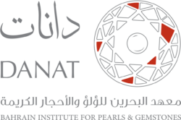DANAT and Supreme Council for Environment assess pearl oyster beds in Bahrain
The Bahrain Institute for Pearls and Gemstones (DANAT), in partnership with the Supreme Council for Environment, concluded the first phase of a study project to assess the state of Bahrain’s pearl oyster beds. The research study was commissioned to assess the impact of the National Plan to Revitalize the Pearl Sector on the pearl beds after its debut in 2017. The study’s purpose was to provide policymakers with a statistical analysis of the current state of the pearl oyster beds and to make recommendations to ensure sustainable pearl fishing practices. The research study was supported by the Directorate of Fisheries at the Ministry of Works, Municipalities and Urban Planning, the regulators of pearl fisheries in Bahrain.
During the initial phase of the project, the research team surveyed chosen places in the UNESCO World Heritage Sites of Hayr Bu Ammamah, Hayr Bul Thamah, and Hayr Shtayyah, as well as the famous pearl oyster beds at Fasht Al Adham. The information gathered in Fasth Al Adham is crucial, particularly since the area was last surveyed in 1989.
The current data gathered by project scientists seeks to evaluate the status of the pearl oyster beds by analyzing pearl oyster density and abundance, as well as changes in the population size structure and pearl yields across the surveyed sites. Preliminary data from a temporal comparison between 2012 and 2021 suggest that there are no significant differences in the population density and abundance of the assessed pearl oyster beds. As a result, the pearl oyster beds are not experiencing depletion.
Furthermore, data analysis of the pearl yields indicate that the stock in the Northern pearl oyster beds remain consistent. The study also identified demographical changes in the oyster population structure, from a dominant older generation to a younger generation, which need to be examined further.
H.E. Dr. Mohamed bin Mubarak Bin Daina, Bahrain’s Special Envoy for Climate Affairs and chief Executive of the Supreme Council for Environment noted that the Northern pearl Reserves, which include Hayr Shtayyeh, Hayr Bu Am’amah and Hayr Bul Thamah in addition to Najwat Bul Thama reserve, have been announced as the largest marine reserve in the region, according to the Resolutions No. (2) and (3) of 2017 issued by His Royal Highness Shaikh Abdullah bin Hamad Al Khalifa, the Personal Representative of His Majesty the King and President of the Supreme Council for Environment. These reserves include pearls and coral reefs. The importance of declaring these reserves is to preserve the natural resources in the region, ensure their continuity for the coming generations, and to achieve the optimal use of natural resources to ensure their sustainability.
Dr. Bin Daina added that The Supreme Council for Environment has undertaken an important role to revive Bahrain’s pearling industry. SCE has organized a series of training courses for applicants who wish to obtain an oyster-harvesting license.
These courses included an explanation of oyster-harvesting regulations and how to preserve this natural wealth and utilize it in a sustainable manner that ensures the preservation of the marine environment and the unique natural resources that Bahrain enjoys.
He added that the Supreme Council for Environment held a set of training programs and workshops for divers to encourage the preservation of this profession in a manner that ensures the sustainability of the environment to be suitable for the production of natural pearls. Regulations related to diving licenses have been introduced to control pearl hunting process and to apprehend violators by declaring Al Hayrat a protected area in order to ensure the reproduction of oysters. A decision was also issued by the Ministry of Works, Municipalities Affairs and Urban Planning to organize pearl hunting and harvesting to attract citizens, residents and tourists to dive and extract pearls and introducing it as part of the Bahraini heritage to encourage and preserve the continuity of this profession in a manner that ensures the sustainability of the environment that allows the production of natural pearls. Regulations related to diving licenses were also presented to control the pearl hunting process and detect violators, as well as activating maritime control, regulating pearl hunt and harvest, and preventing any abuses and violations that may occur, including harvesting without a license. From this point of view, the Supreme Council for Environment considered the importance of conducting a field survey to study the impact of hunting and pearl extraction on the natural reserves of pearl, as the results of this study will contribute significantly to making decision that suit the nature and importance of these sites.
Mrs. Noora Jamsheer, CEO of the Bahrain Institute for Pearls and Gemstones (DANAT), indicated that the research with the Supreme Council for Environment will produce recommendations for the sustainability of Bahrain’s pearl oyster beds. She added that advancing Bahrain’s pearling industry lies in the collaborative effort of the various stakeholders, noting the fruitful partnership with the Supreme Council for the Environment and the Directorate of Fisheries at the Ministry of Works, Municipalities and Urban Planning.
Mrs. Jamsheer indicated that the project was a top priority for DANAT’s research team, and that significant resources have been allocated to run the project. The findings of the study will help policymakers to monitor the national plan and will pave the path for the development of a national natural resource plan for pearls.


